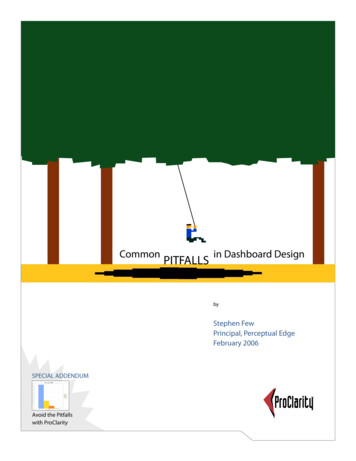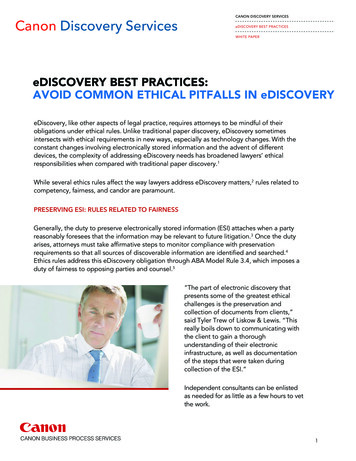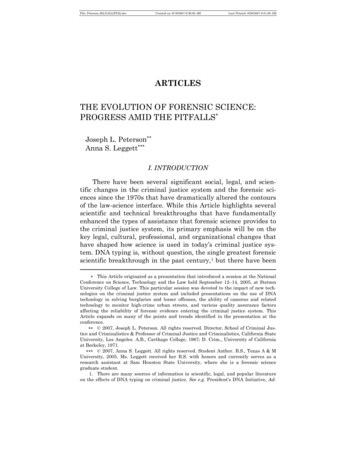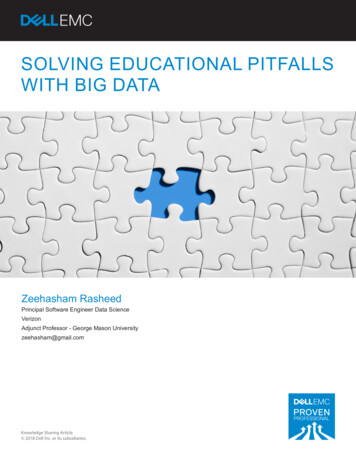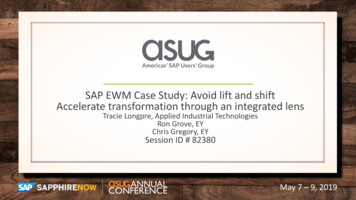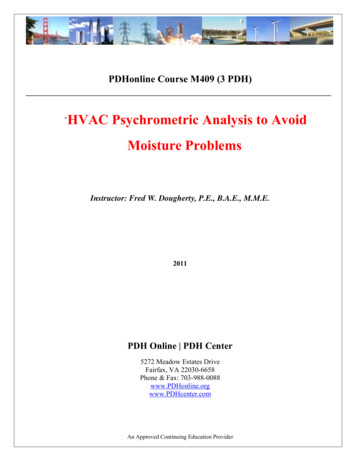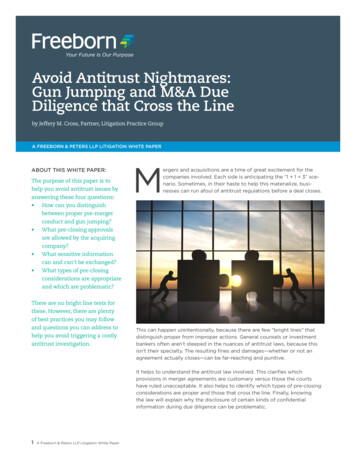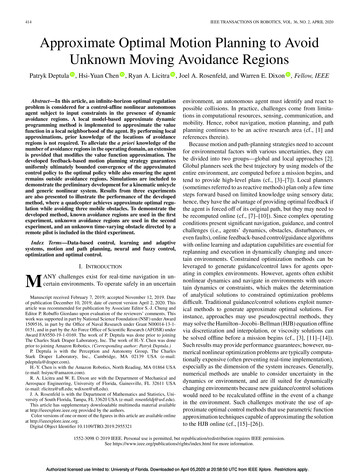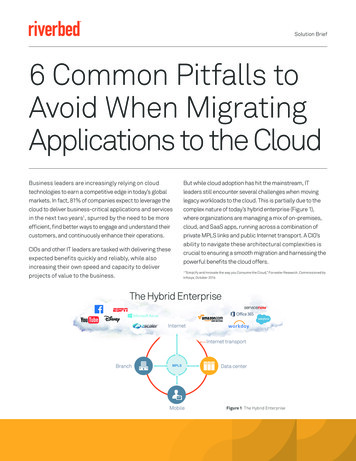
Transcription
Solution Brief6 Common Pitfalls toAvoid When MigratingApplications to the CloudBusiness leaders are increasingly relying on cloudtechnologies to earn a competitive edge in today’s globalmarkets. In fact, 81% of companies expect to leverage thecloud to deliver business-critical applications and servicesin the next two years1, spurred by the need to be moreefficient, find better ways to engage and understand theircustomers, and continuously enhance their operations.CIOs and other IT leaders are tasked with delivering theseexpected benefits quickly and reliably, while alsoincreasing their own speed and capacity to deliverprojects of value to the business.But while cloud adoption has hit the mainstream, ITleaders still encounter several challenges when movinglegacy workloads to the cloud. This is partially due to thecomplex nature of today’s hybrid enterprise (Figure 1),where organizations are managing a mix of on-premises,cloud, and SaaS apps, running across a combination ofprivate MPLS links and public Internet transport. A CIO’sability to navigate these architectural complexities iscrucial to ensuring a smooth migration and harnessing thepowerful benefits the cloud offers.1“Simplify and Innovate the way you Consume the Cloud,” Forrester Research, Commissioned byInfosys, October 2014Figure 1 The Hybrid Enterprise
Here are 6 Common Pitfalls that Hinder an Organization’s Ability to SuccessfullyMigrate Applications to the Cloud1. Having an incomplete or outdated view of theinfrastructure4. The proper adoption tracking and performancecriteria haven’t been identified2. Network bandwidth and latency constraints aren’tknown or understood5. Not enough time has been allocated for themigration to take place3. No visibility into how the application is performingthroughout the migration process and beyond6. Application, network, and security teams continueto operate in silosPitfall 1: Having an Incomplete or Outdated View of the InfrastructureThe situationLifting and shifting on-premises applications and gettingthem properly designed, mapped, and then migrated tothe cloud is a complex scenario. The to-be-migratedapplications may consist of hundreds of microservices,make calls to multiple databases, and integrate withcomponents from several different third parties.IT needs to know these components inside and out, andunderstand what services communicate with one another.Otherwise, the application delivery chain will break andsome associated services may experience unexpecteddowntime or performance degradation. Yet many ITorganizations lack a current view of their applicationarchitectures, often the result of a sprawling, dynamicinfrastructure where applications and servicesare continually added or modified, servers that aredecommissioned or consolidated, and other changesand moves that aren’t always clearly documented.Recommended actionsTake principles and lessons learned from data centermigrations and other consolidation efforts, and applythem to cloud projects. Introducing applicationdependency mapping software can significantlystreamline the discovery and planning phase whileproviding IT leaders with a complete and accurate view ofthe entire application landscape, as well as visibility intoperformance issues during and after the migration.Riverbed’s solutionRiverbed SteelCentral NetProfiler is a centralizedreporting and analysis console that combines networkflow data with packet-based performance metrics. Itincludes a discovery wizard that creates applicationdashboards to automate the process of mappingtransactions to their underlying infrastructure so thatapplication definitions and interdependencies areaccurate. NetProfiler can also create service maps,further accelerating the planning process for cloudbased migrations.Relying on a clipboard audit and interviewing applicationstakeholders isn’t enough. To mitigate risk and preventunwanted outages, IT leaders must understand thesecritical, hidden dependencies and validate howapplication components actually talk before theystart the migration process.Riverbed Solution Brief2
Pitfall 2: Network Bandwidth and Latency Constraints Aren’t Known or UnderstoodThe situationMoving applications and data to the cloud imposes newdemands on the corporate network and impacts twoperformance constraints: bandwidth and latency. Notunderstanding the true ramifications on these twoconstraints can easily offset the expected businessvalue of moving to the cloud in the first place.During and after the migration, bandwidth utilizationincreases and traffic patterns begin to vary significantly.Quite often, network links become saturated, which candegrade the end-user experience of both existingapplications and the newly deployed cloud application.Hybrid networking, which combines reliable MPLS andfast Internet links, has emerged as a cost-effective wayto maintain the appropriate amount of bandwidth whileensuring optimal performance for companies leveraginga mix of cloud and on-premises applications. As a result,customers now have options to send a portion of theirtraffic over the public Internet as an alternative toupgrading their MPLS links. Using IPSec technology, theycan backhaul the less critical traffic to the data centerand, therefore, make room for business-criticalapplications over the MPLS links.But in traditional network architectures, where the trafficis backhauled to a central gateway located in thecorporate data center, cloud-based applications end uptraveling a longer distance to reach users when comparedto their on-premises equivalents. Therefore, the time ittakes to complete a business transaction may increase,sometimes dramatically, due to the added latency.This problem can be alleviated by using local Internetbreakouts, enabling direct connections from branchesto the Internet instead of backhauling traffic to a centrallocation. At the expense of additional security costs, theperformance of the cloud application can significantlyimprove as the latency decreases.However, this does not mean that latency completely goesaway. As with traditional on-premises applications, acloud-based application is hosted in a specific location.And in a distributed organization, that location, bydefinition, cannot be close to every user.Recommended actionsStart the cloud migration project with an assessmentphase. Visualize and quantify these end-to-end networkconstraints by testing key business transactions on apre-migration basis. Using predictive analysis and networkmodeling tools can help evaluate current performance anddetermine areas for improvement by pinpointing whereexcessive time and bandwidth are spent within theinfrastructure as the transactions are tested.Once those baselines are completed, explore alternativesto buying more bandwidth when addressing overtaxedlinks. WAN optimization controllers, for instance, canstreamline the movement of large chunks of data,reducing network utilization and associated costs whileaccelerating applications and increasing businesstransaction throughput.Next, consider ways to maximize the usage and flexibilityof today’s hybrid networks. While hybrid networking can becomplex, there are solutions that mitigate that complexityby using dynamic and application-aware path selectionand quality of service (QoS).When appropriate, take cloud-destined traffic direct tothe Internet, eliminating extra hops between the cloudand employees.For latency-sensitive applications, such as MicrosoftOffice 365, or custom applications running in Amazon WebServices or Microsoft Azure, consider WAN optimizationtechnologies that specifically address the needs ofcloud-based applications.Riverbed Solution Brief3
Riverbed’s solutionsRiverbed SteelCentral Transaction Analyzer is theindustry-leading solution for application networkreadiness testing. By running “what-if” scenarios, you cantest critical business transactions to predict the impact ofchange on application response times before you migrateto the cloud and validate proposed solutions—includingWAN optimization—before deployment by assessing theeffects of adjustments made to network and applicationparameters.Riverbed SteelHead is the industry’s #1 optimizationsolution that accelerates delivery of all applications acrossthe hybrid enterprise. With SteelHead SaaS, you canoptimize cloud-based services and SaaS applications,including Microsoft Office 365 and Salesforce.com, byproviding up to 33 times faster performance and reducingbandwidth by up to 97%. And with integrated quality ofservice (QoS) and business-intent path selection,SteelHead provides CIOs the ability to control networkconsumption, as well as what cloud applications usewhich network, by prioritizing business-critical andlatency-sensitive applications over recreational apps.Lastly, the solution secures optimized and non-optimizedtraffic over hybrid networks with standards-basedencryption for added security and regulatory compliance.Pitfall 3: No Visibility into How the Application is Performing Throughout theMigration Process and BeyondThe situationRecommended actionsWhen performance problems do occur—whether asa result of the previously covered pitfalls or anotherunderlying cause—IT leaders need the ability to quicklypinpoint and resolve the issue. However, the cloudintroduces an order-of-magnitude increase incomplexity when trying to mitigate the impact ofperformance problems.Bringing back some level of visibility and control iscritical to maintaining performance and a consistentuser experience in the cloud—throughout the migrationprocess and beyond. Having the proper application andnetwork monitoring tools in place allows IT organizationsto decrease mean time to resolution (MTTR), reducingsupport tickets and cutting technical costs related tomigrating and supporting the cloud application. Andwhen performance issues stem from cloud providers’services, it allows IT to quickly escalate and hold theproviders accountable for agreed-upon service-levelagreements (SLAs).Why? Because now that the application has been migratedor is in the process of being moved to a cloud or SaaSprovider’s environment, IT is relinquishing someadministrative control. The enterprise no longer owns orhas direct access to the infrastructure upon which itsapplication is now hosted. Yet, IT is still responsible for theperformance and security of those services.Making matters more difficult is that IT loses visibility intoapplication performance. The question of whether aproblem stems from the network or the application itselfnow extends to the cloud—perhaps the provider’s servicesare experiencing issues. If it’s on the cloud provider’s end,internal staff members no longer have quick access to thepersonnel who can directly troubleshoot the anomaly.In today’s highly distributed enterprises, where branchesand other remote sites are often the frontline, revenuegenerating portions of the business, having end-to-endvisibility is even more imperative when delivering cloudbased applications and services. These “eyes at thebranches” allow IT to stitch the entire picture togetheracross infrastructure components—WAN optimizers, loadbalancers, firewalls, SDN protocols, etc.—increasing thereliability of critical IT services.Riverbed Solution Brief4
Riverbed’s solutionsRiverbed SteelCentral AppInternals empowers youto take control of applications running on and off the cloudwith end-to-end performance visibility. Installed in justminutes, AppInternals can query and analyze billions oftransactions to discover bugs, draw business insights, andhelp deliver a superior experience in the cloud.Riverbed SteelCentral AppResponse extendsperformance monitoring into applications running inSaaS environments by integrating with SteelHeadappliances to provide end-to-end visibility across theentire network at the lowest cost. AppResponse is theonly solution to measure end-user experience for bothSteelHead-optimized and non-optimized enterpriseweb and SaaS applications for faster, more effectivemonitoring and troubleshooting.Pitfall 4: The Proper Adoption Tracking and Performance Metrics Haven’t Been IdentifiedThe situationRecommended actionsWhen IT leaders make a significant investment inmigrating an application to the cloud, they should beable to tie end-user adoption and performance back tothe business story. How many users are leveraging thecloud-based application? What does their usage profilelook like? Or are they still using the legacy or on-premisesversion of the application?Meet with project stakeholders—from both the businessand IT—and clearly define usage requirements,expectations, and success criteria as part of themigration-planning phase. Next, evaluate what tools areavailable for collecting the adoption- and performancebased metrics, and determine what gaps in monitoringand reporting exist.Defining key user adoption and performance metricshelps IT measure the success of the migration and thenew application. And for organizations that are in the firststages of their cloud adoption strategy, such datapoints are critical for validating or adjusting strategiesand justifying future cloud spend.With that assessment in place, finish instrumenting theinfrastructure with the right network and applicationmanagement tools that can provide actionable insights.This is particularly important for organizations usingpublic cloud to burst from a private data center, wheremeasuring performance across both environments with asingle source of truth is critical for situational awareness.The problem, however, is that many organizations failto establish clear metrics and usage policies beforethe rollout begins. As a result, they only define thesemetrics on a reactive basis, when it’s time to reportback to key stakeholders. And even when those metricsare defined, the proper instrumentation to collectactionable intelligence is often still missing, as pointmonitoring or management solutions only tell part ofthe story.Riverbed’s solutionRiverbed SteelCentral Portal integrates data fromSteelCentral and SteelHead solutions to create acentralized, dynamic view of an application performanceenvironment. This holistic view gives operational teams asingle source of truth for application performance,accelerating troubleshooting and providing meaningfuldata for stakeholders throughout the enterprise.Ultimately, IT is able to efficiently control and optimizeapplications, data, and traffic across the entire hybridnetwork—including in the cloud—keeping key resourcesfocused on strategic projects.Riverbed Solution Brief5
Pitfall 5: Not Enough Time Has Been Allocated for the Migration to Take PlaceThe situationMigrating a critical workload to the cloud won’t take placeovernight. In fact, when organizations start moving data,they often find that it moves slower than expected. Thatdata migration, in essence, becomes the bottleneck to theentire project.A perfect example is migrating from legacy email systemsto a more collaborative platform like Office 365. Here,migrating the mailboxes alone can consume significantnetwork resources. In one customer’s case, Riverbedfound that an initial inbox synchronization for just 10 pilotusers ate up 10% of the Internet link2. So imagine whathappened when 1,000 users migrated a few days later.Also, keep in mind that as users are exposed to featurerich capabilities—such as Lync for voice, video, anddesktop sharing—more bandwidth will be consumed,as all applications compete for a finite amount of WANresources. This means that constraints are intensified,timelines are thrown off, costs increase, and IT strugglesto deliver the intended business value on schedule.Recommendations actionsAs previously mentioned, understanding bandwidth anddelay constraints before the migration starts will providecritical insights for successfully estimating timelines,allocating resources, projecting costs, and forecastingrisks. So build more than adequate time into projecttimelines. Also, consider conducting pre-migration studiesto analyze delay and bandwidth constraints whenmigrating the data and workloads themselves.That way, cutovers aren’t confined to nights or othernon-peak times, thereby expediting the migration. Lastly,identifying, marking, and shaping appropriate cloudapplications is key for ensuring a great user experience,gaining adoption, and reducing help desk calls as usersare cut over.Riverbed’s solutionsEnterprises worldwide rely on Riverbed ProfessionalServices (RPS) when moving critical applications tothe cloud. With the Cloud Migration Assessment,organizations gain a full view of their applicationinfrastructures before they migrate to reduce costs,minimize risk, and eliminate business disruption. Theservice combines application discovery, dependencymapping, and risk assessments so IT can confidentlymove complex applications to the cloud while ensuringperformance demands are met and businessobjectives are achieved.Understanding that Office 365 is a mission-criticalplatform for most enterprises today, RPS also offersa full suite of consulting solutions to support customersthroughout the migration process—from planninginto production and beyond. Delivered using Riverbedproducts and proven methodologies, Riverbed ConsultingSolutions for Office 365 ensure a smooth transition to thecloud—accelerating projects and reducing risk, costs, andbandwidth usage.Next, prioritize your limited WAN resources accordingly—upgrading circuits and hoping things go well isn’t a strategy.Bring some reliability and predictability to the project byfactoring in a WAN optimization component to help migratedata faster, and reduce the load on the WAN path byaround 75% or more. And tune QoS strategies so that batchmigrations can take place during the workday withoutaffecting critical business traffic or congesting the network.2“How to Avoid Saturated Links and Performance Problems During Office 365 Migrations,”Riverbed, July 7, 2014Riverbed Solution Brief6
Pitfall 6: Application, Network, and Security Teams Continue to Operate in SilosThe situationMoving a workload to the cloud must be considered a realIT transformation and requires disparate IT teams to workas a cohesive unit for sustained success. But all too often,application, network, and security teams only focus ontheir individual domains: The application team leaders are concerned withmaintaining productivity and a consistent, superioruser experience The network side is responsible for managing oneof the key constraints in the end-to-end enterprisearchitecture; that application must not breakeverything else in the mix The security team ensures application and networkusage policies coincide within the establishedframework that was put in place to protect sensitivecompany informationHowever, the cloud is driving many considerations forrevamping the enterprise architecture and, as a result,responsibilities become blended efforts. For example,what team is charged with troubleshooting issues? In somecases, it’s the network team, even if the impacted service isa SaaS application.As a result, the war room scenario becomes more complex.And instead of finger pointing within a single “country,”stakeholders from multiple countries must have seats atthe table, which introduces more politics and policy.The implication here is that completing a cloud migrationproject, and then maintaining a superior end-userexperience moving forward, is a shared effort. Whenit comes to forming and executing a successfulenterprise-wide cloud adoption strategy, unity acrossIT becomes even more imperative.Recommended actionsTearing down these silos and developing a cross-functionaltaskforce helps organizations become more prepared andensures a smoother rollout. Take what’s been successful inDevOps with regard to collaboration, speed of improvement,and a culture of efficient responsibility and apply it acrossall of IT.Think about the manufacturing process of continuousimprovement. While manufactur
Riverbed SteelCentral Transaction Analyzer is the industry-leading solution for application network readiness testing. By running “what-if” scenarios, you can test critical business transactions to predict the impact of change on application response times before you migra
